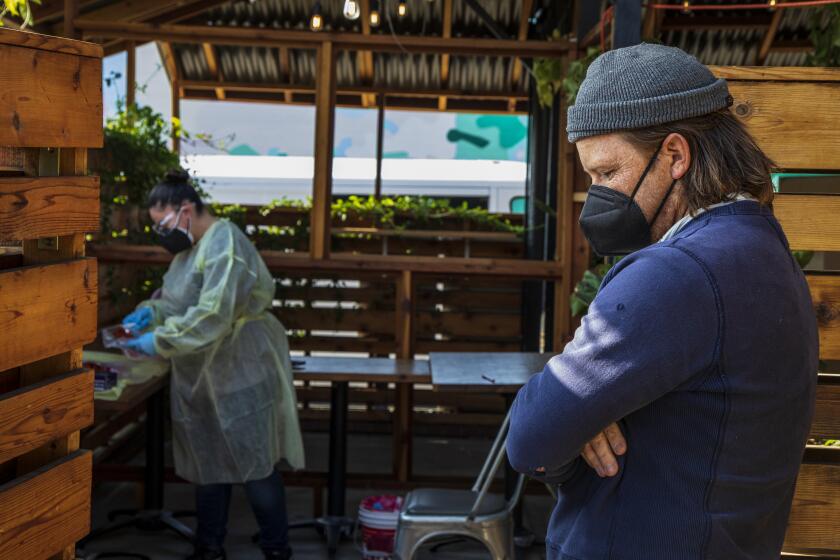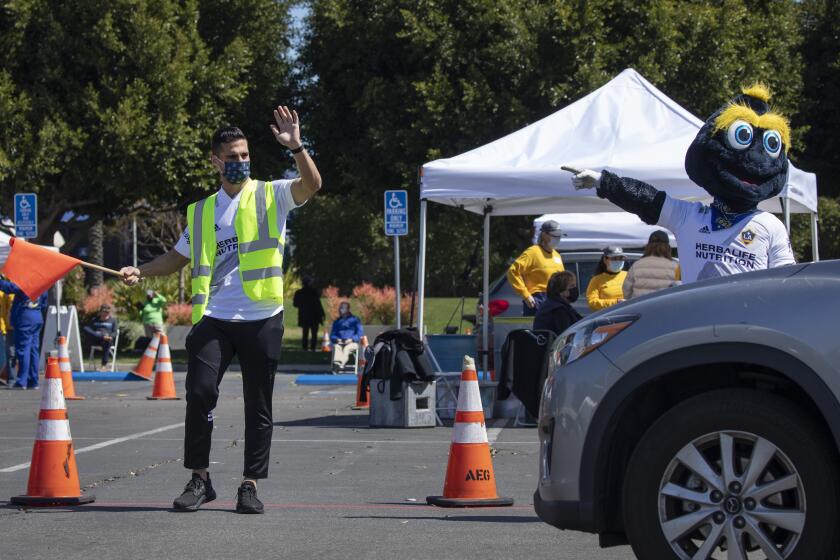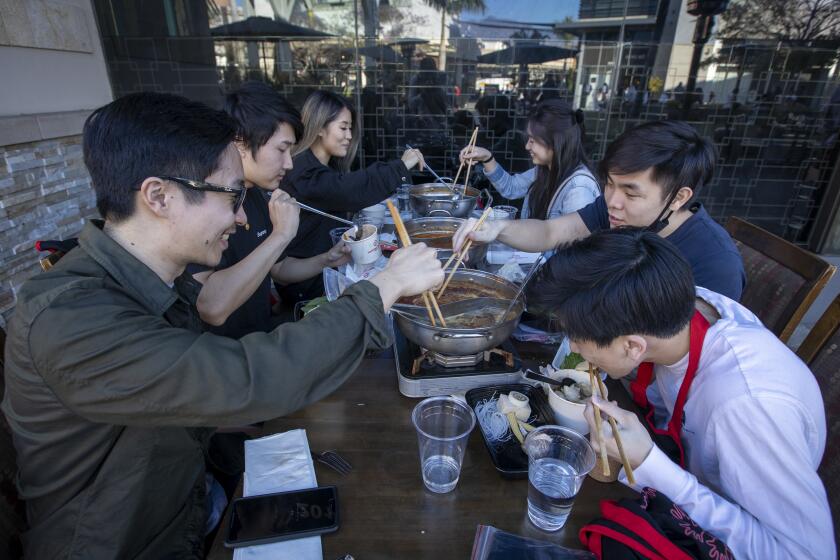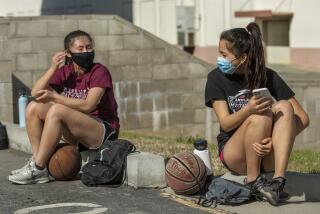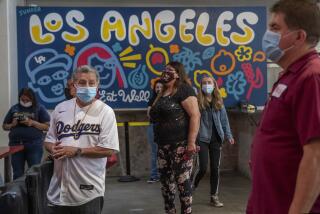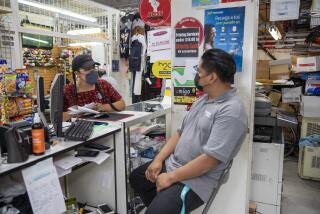As L.A. eyes orange coronavirus tier, is another wave of reopenings around the corner?
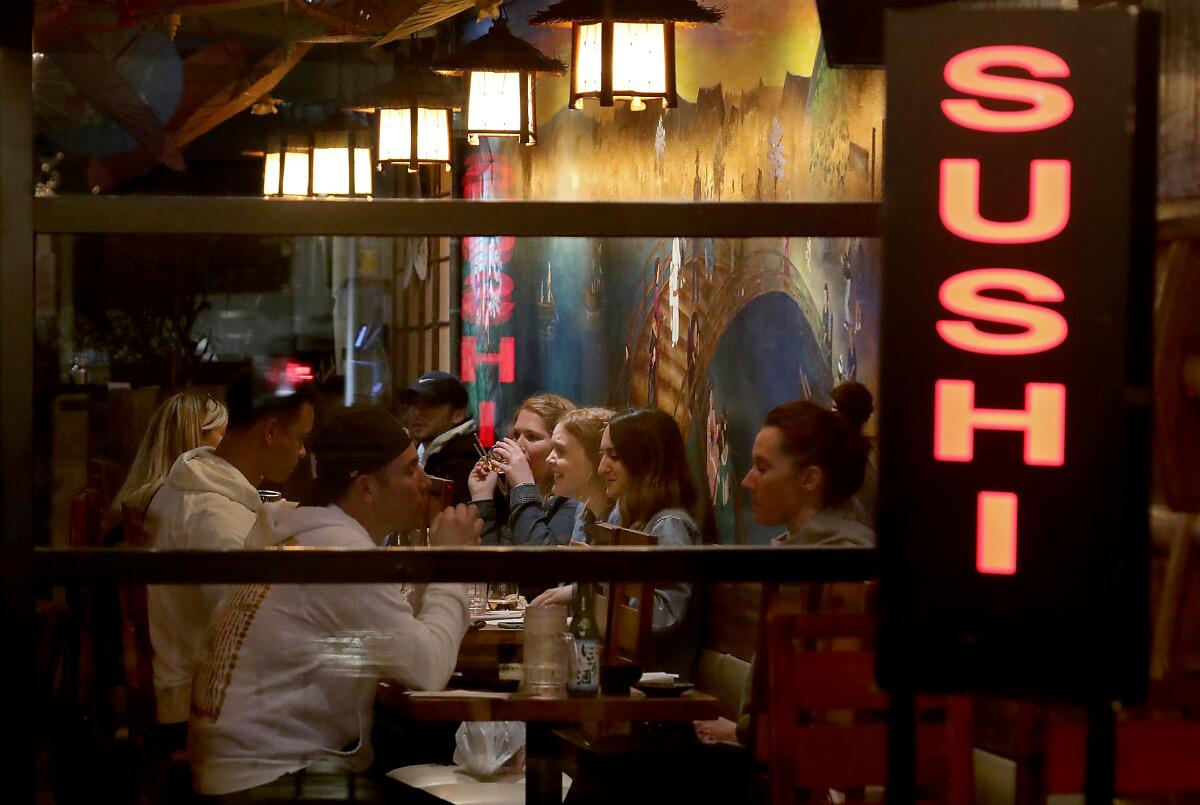
- Share via
A wave of reopenings has recently washed over California. Could more be around the corner?
In Los Angeles County, which only days ago moved into the red tier for the first time since the state unveiled its four-category color-coded coronavirus reopening blueprint, officials are already eyeing the possibility of further advancement.
Should current trends continue, it’s possible the county could enter the even more lenient orange tier next month, said Public Health Director Barbara Ferrer.
But, she stressed, “we get there together, by playing by the rules.”
“I am relieved that we are in our recovery, where more and more people are being vaccinated and cases, hospitalizations and deaths continue to decrease — but it has come at a huge price,” she said during a briefing Wednesday.
“And I know that there are many like me remembering what we’ve been through and how the lives of so many have been forever changed by this pandemic. These memories ought to remind us that we owe it to ourselves and to our community to get to the other side of this pandemic, being as careful as we can to prevent more illness and death.”
With most counties having now emerged from California’s purple tier and freed themselves from the strictest limitations on activities and businesses imposed in response to the COVID-19 pandemic, attention is turning to the path ahead and how quickly a wider economic unlocking could take place.
San Diego, Riverside, Ventura and Santa Barbara counties were among those freed from the most-stringent tier in California’s reopening plan
Some areas, like L.A., are poised to move forward given a little time and a bit of improvement. Others could forge ahead as soon as next week provided their numbers stay steady.
That the possibility of more movement exists at all reflects two related trends: California continuing to gain ground in its battle against COVID-19 and doses of vaccine steadily being administered.
Under California’s reopening strategy, counties are sorted into one of four tiers — purple, where coronavirus transmission is considered widespread and indoor operations are suspended or severely limited across a wide swath of business sectors; red; orange; and finally, yellow, where most businesses can be open indoors with modifications.
Tiers are assigned based on three factors: COVID-19 case rates, the rate of positive test results and a health-equity metric intended to ensure that the positive test rate in poorer communities is not significantly higher than the county’s overall figure.
Southern California cycling studios can open at 10% capacity, but while they were closed, Peloton amassed a legion of exercisers who may not go back.
Counties need to record two straight weeks of qualifying data to advance to a less-restrictive tier and must remain in a tier for at least three weeks before moving again.
To move from the red to orange tier, a county must have an adjusted coronavirus case rate of 3.9 or fewer new cases per 100,000 people each day, a test positivity rate of under 5% and a health equity metric of less than 5.3%.
According to the latest data released Tuesday, L.A. County checked both the health equity and positivity rate boxes, but its calculated case rate — 4.1 — was still a tad too high. The county remains two weeks away, at best, from potentially advancing.
Orange County is in the same boat, with two qualifying metrics but an adjusted case rate of exactly 4.0.
Other areas are positioned to move sooner, however. Per state data, San Francisco, Santa Clara, Trinity, Lassen and Yolo counties could all enter the orange tier next week, provided their numbers hold.
Currently, four counties — Plumas, Sierra, Mariposa and San Mateo — are in the orange tier, and only Alpine County has made it all the way to yellow.
Soccer team uses stadium site to help people from underserved communities
Counties that reach the orange tier can allow bars to reopen outdoors, with modifications, without needing to serve food.
Additionally, capacity restrictions are lifted in stores (although pandemic safety modifications still apply); allowable indoor capacity increases from 25% to 50% for places of worship, museums, zoos and aquariums; maximum indoor restaurant and movie theater capacity rises from 25% or 100 people, whichever is fewer, to 50% capacity or 200 people, whichever is fewer; and indoor gym and yoga studio capacity rises from 10% to 25%.
Local-level health officials can opt to maintain stricter standards than those outlined in the tier framework.
Only recently have a significant number of counties begun to escape the purple tier following the state’s horrific fall and winter coronavirus surge. As of this week, only 11 counties remained in that category: Glenn, Yuba, Nevada, San Joaquin, Stanislaus, Merced, Madera, Fresno, Kings, Inyo and Kern.
Within the past week, 23 of the state’s 58 counties have advanced into the red tier, including L.A., San Diego, Orange, Riverside, San Bernardino, Sacramento and Ventura.
“We saw a lot of movement last week; we’ve seen a lot of movement this week; you’re going to see even more movement next week,” Gov. Gavin Newsom said Tuesday.
Progressing from the purple tier was made easier after state officials redrafted the reopening roadmap upon meeting a goal of administering 2 million COVID-19 vaccine doses in California’s most disadvantaged communities.
When that happened last Friday, the state began allowing counties with an adjusted case rate of up to 10 new cases per day per 100,000 people to exit the purple tier. Previously, counties needed to have case rates at or below seven per 100,000 people to move into the red tier.
The criteria would loosen further when the state hits its next target of doling out 4 million doses in targeted areas — those within the lowest quartile of a socioeconomic measurement tool called the California Healthy Places Index.
After reaching that mark, the threshold to move into the orange tier would be relaxed from a requirement of under 4.0 new cases per day per 100,000 residents to under 6.0. Entering the yellow tier would necessitate an adjusted daily new case rate below 2.0 per 100,000 people, compared with the current requirement of less than 1.0.
While those changes would further accelerate the pace of reopenings, they remain some distance off. As of Wednesday morning, nearly 2.4 million vaccine doses had been administered in the communities of focus, according to the state.
Earlier this month, officials announced that California would begin dedicating 40% of its available supplies for residents in those most disadvantaged areas — an allotment state officials say is aimed at addressing the stubborn inequities that have dogged the vaccine rollout.
Despite the dedication, the imbalance remains, and fewer vaccines have been administered in communities on the lowest end of the index than any other quartile. By comparison, nearly 4 million shots have been given out in the highest-quartile areas.
“We’re still not close to where we need to be,” Newsom said. “I’m looking at these numbers every day — even two weeks into this, those numbers are stubborn.”
Statewide, providers have administered some 13 million doses to date, Times’ data show.
Here’s a timeline of when restaurants, gyms, theme parks, museums and more can reopen in Southern California.
California’s recent progress, though promising, isn’t inevitable, and health officials stress that continued vigilance is necessary to keep the state on the right path.
“We always worry about cases going back up. That’s why we try to remind everyone that we all know what we need to do to make sure that doesn’t happen,” Ferrer said. “We’re going to worry until we get to a place where we have the vast majority of people here in L.A. County vaccinated.”
Until that happens, Ferrer said everyone should continue striving to protect themselves and those around them from the coronavirus — by taking familiar steps such as wearing masks in public, regular handwashing, maintaining physical distance and avoiding crowds, particularly indoors.
Holidays — and the typical group celebrations that accompany them — have been of particular concern throughout the pandemic. St. Patrick’s Day was no different.
“We know all too well what happens when we stop, even for just one day, doing what we know prevents the transmission of COVID-19,” Ferrer said. “A relatively small gathering can have serious unintended consequences, leading to people becoming sick and even dying. Right now, with as much progress as we’ve made, it’s simply not worth moving backwards for a night of celebrating in ways that aren’t safe.”
Times staff writer Rong-Gong Lin II contributed to this report.
More to Read
Sign up for Essential California
The most important California stories and recommendations in your inbox every morning.
You may occasionally receive promotional content from the Los Angeles Times.

